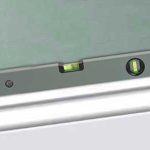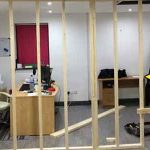Whether you are working on a new build or a refurbishment, the jobs you carry out will generally be done in a specific order. The process is divided into two main sections, these are known as first fix, and second fix.
Second fix is everything after plastering. As skirting boards and architrave are second fix joinery, they are done after all the plastering is complete. Once the plaster is dry, the architraves will be added first, and the skirting boards will follow.
By adding skirting boards after plastering, you will achieve a much neater finish. The boards will cover any gaps between the floor and the skimmed walls. Likewise, the architrave will cover any gaps between the walls and door casings.
What would happen if skirting went on before plastering?

If you skimmed after adding your skirting boards, it would be much more difficult to achieve a decent finish. Also, your skim coat would be around 2-3mm thick, this would considerably overlap the skirting board.
For example, certain skirting board moulds, may only have a thickness of 5mm at the top of the board. Due to this, it would be very easy to lose this 5mm, especially if your walls were slightly uneven, and the skim needed building out towards the bottom.
Another issue you would face, is the mess. Plastering is not the cleanest of trades and even with the best intentions, it will be very difficult for a plasterer to cause zero mess.
If you already have skirting boards fitted, it is very likely they will get plaster on them. Once the plaster dries hard, it will need to be removed, and it is likely to stain the boards.
As a rule of thumb, every piece of second fix work, would be started after plastering. Initially this would include all the second fix electrics, plumbing, carpentry, etc. This would be followed by all other finishing trades, such as decorating and flooring.
Every one of these jobs will have a neat finish and they will all be visible after the job is complete. Therefore, they don’t want splattering with plaster. Usually, a project will be looking a lot neater during second fix.
First fix is much messier than second fix, and most of the work will be hidden below the surface. Plaster provides a smooth, clean finish for second fix to build off. Once walls are skimmed, the entire job starts to really come together. Most of the work after this point, is more detailed and designed to provide a perfect finish.
Do you ever plaster after skirting?
As we have already mentioned previously, it is best practice to plaster first. However, there are certain instances where you may need to plaster after skirting boards are fitted.
This will nearly always be existing skirting boards. For example, if you are refurbishing a property, or renovating a room in your own home. Sometimes you may already have the skirting boards fitted and perhaps you are just over skimming the surfaces.
It can be acceptable, to simply skim up to your skirting and architrave in this instance. However, this is very dependent on the specific job. It is not a one size fits all solution.
Really, for the best finish, you would remove the skirting and then add back once the plastering has been done. However, this is not always possible. For example, if you think removing the skirting will damage the existing walls, or even the skirting itself, you may opt to leave it in place and just skim up to it.
In this scenario you will really need to weigh up the pros and cons.
Some things to consider
- The style of skirting board mould – As we mentioned previously 2-3mm of skimmed plaster will cover a bit of the skirting board thickness. For something like pencil round or square edge skirting moulds, this is less of an issue.
However, moulds such as ogee or taurus have a much thinner top edge, this will mean skimming up to them is much more obvious. - The location of the skirting – How visible the skirting is, and where it is, will also be worth considering. For example, if we are talking about an entrance hall, with nine inch taurus skirting boards on display. This is very different to six inch pencil round in a utility room.
The former is much more visible and decorative.Therefore, it would make sense to remove the boards and add back after plastering. However, the latter is probably less of an issue, and you could get away with just skimming up to the existing boards. - Condition of the walls – You may also consider the damage you will cause removing the skirting. If they are fixed well, there is a chance you damage the wall and the skirting removing them. This will mean additional work to fix damage to the walls, as well as potentially needing to add new skirting.
As you can see, there are a several things to consider here. The decision you choose will depend on the specific circumstances. Just be aware that skimming up to existing skirting board will not give the best possible finish.
Conclusion
It is best practice to add skirting after all plastering is completed. Skirting boards are a second fix job and they will be visible once your job is complete. For this reason, you should be aiming for the highest possible quality finish.
Plastering after skirting will affect the quality of finish, it is not common best practice. However, there are certain exceptions to the rule, and it is sometimes acceptable to skim up to existing boards. With that said, in the vast majority of cases, it will lead to a lower quality finish, so the extra work of removing boards, plastering and then refitting is usually the best choice.




